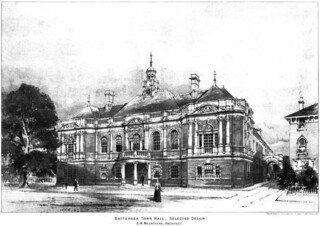In Battersea
Rosemary Hill
Battersea Arts Centre, badly damaged by a fire last Friday, started life as the town hall. In the spirit of late Victorian civic pride and aspiration, the capacious porch is decorated with figures representing Labour, Progress, Art and Literature instructing the infant Battersea, who looks remarkably confident about the likely benefits coming his way. Built in 1892-93 to the designs of E.W. Mountford (the architect of the Old Bailey), the imposing exterior anticipates Edwardian Baroque while the interior is tinged withthe dawning of art nouveau, most strikingly in the great coloured glass dome, painted with tendrils of golden foliage, like a giant Tiffany lampshade.
The dome has been saved and the Centre was quick to praise the fire brigade, who managed also to protect much of the front of the building, although the Grand Hall seems to have been lost. It's not yet known what caused the fire, but it conforms to a sadly familiar pattern. Like the Cuming Museum in Southwark, badly damaged in 2013 by a fire started by a roofer's blow torch, the Arts Centrewas undergoing repairs and was in the last phase of a £13.3 million restoration project. The National Trust's Uppark in 1989, Windsor Castle in 1992 – the list of buildings that have suffered more from accidents during repair than from neglect is depressingly long.
Response to the fire has been quick, with £52,000 raised in two days and lively campaigns on social media. (You can donate here.) It's a tribute to the Centre, which has been held in great affection locally and nationally, since the Town Hall was converted in 1974, and it is also a tribute to the building, which has responded well to decades of adaptation. 'Victorian' is still a term of architectural abuse. Holes in the road in London sport notices that smugly announce the replacement of 'Victorian'sewers, as if the problem were with the Victorians rather than the 150 years of neglect that only such solidly built, well engineered structures could have withstood. But the public architecture of the 19th century is not only robust; it is inclusive, generous and flexible.
Rochdale's stupendous town hall (1871, listed Grade One) is currently following Battersea's path. Largely abandoned in 2013 when the council moved to purpose built offices, it's at the start of a five-year plan, led by a group of volunteer 'Friends', to restore the murals, open up the original library space and make two auditoriums. Meanwhile the new council offices, No. 1 Riverside, comprise two wings, one housing a new library, largely unencumbered with books, and centred on that cliché of the last century, a full height glass atrium. Proud winner of the UK Concrete Award for2013, the building is popular with the staff who work in it, but whether it will have as many friends or as much potential for new use as the old town hall when it too reaches its sesquicentenary Idoubt.

Comments
Fortunately, the dog and pot sign from over the ironmongers that Charles Dickens passsed every day aged 12 on his way to the blacking factory must have survived the Cuming Museum fire - and anyway, a replica was made in 2012 to hang at the original spot. But I wonder went up in the fire. I have spent many happy times in the Cuming browsing the oddities and having good ideas.